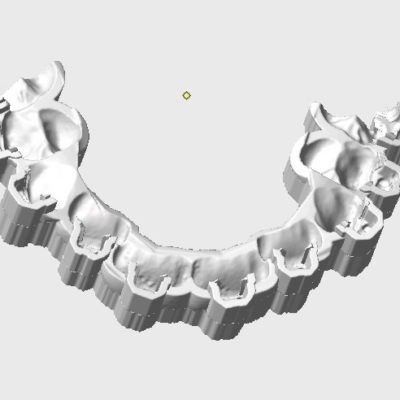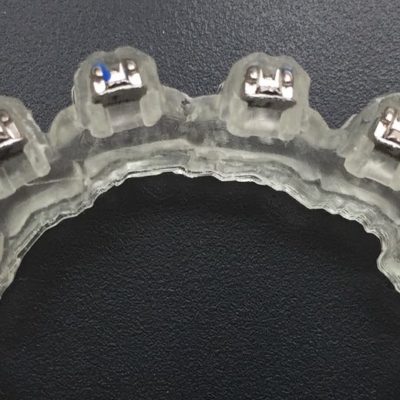Fixed appliances and indirect gluing
In modern orthodontics, fixed appliances belong to the standard repertoire. With the appropriate know-how of the dentist, they are excellent tools for the high-precision solution of any conceivable misalignment.
The handling and biomechanical properties of these devices have been further improved by the straight wire technique. The straight wire technique again requires perfect positioning of the brackets. You can achieve this easily with our completely digitally controlled indirect gluing. You stick more precisely and faster than ever before with a 3d-printed stencil. And with consistent highest quality. Every time.
Achieve better results with more ease. And at the same time save nerves, time and money.
Fixed Appliances
The fixed appliances, especially the multibracket appliances, are nowadays among the most important therapy appliances of modern orthodontics. With it you can correct extremely precise and certainly even the most difficult malocclusions successfully.
The prerequisite is, of course, at least an orthodontic basic education, some experience, and a competent partner for advice and action.
We support you with all questions about fixed orthodontics.
Through our commitment at various universities, the cooperation with established producers and the many years of practical experience from daily practice, we have directly implementable solutions ready for you.
Improve your technique with Dr. Baxmann in the course. Train your staff with the help of our Youtube channel and the many tutorials. We help you in every difficult case through our mentoring program.
For subjects such as biomechanics, materials science or working with straight wire, segmental arches or ricketts technique we are at your side as well as with small but nice tips and tricks for your treatment. Courses can be found in our Orthodontic-e-academy.
We will gladly advise you and supply any equipment you would like to use. You are also welcome to order brackets, bands and bows on a case-by-case basis. Due to our very large order quantities, you have the opportunity to benefit from our discounts!
You have the choice:
- Do you want to use your own brackets and straps, or do you prefer ours?
- Do you want standard sheets or individually pre-bent sheets?
- Do you glue directly, or do you prefer to save time with the high-precision indirect bonding technology?
Further topics of the fixed equipment:
 Indirect Gluing
Indirect Gluing
The indirect bonding technique is an indispensable part of the modern practice routine and integral part of orthodontic treatment technique.
MyOrthoLab takes this technique to a whole new level with fully digitized procedures.
Digitized brackets are perfectly positioned on the scanned digital 3D model in the lab. Individually for the respective patient. Then a digital transmission trail is created by means of software. This individual transfer tray is then printed with elastic biocompatible plastic via 3D printer.
We will send you your tray and equip it with the previously matched up brackets. Or you can have it supplied complete with brackets.
Indirect bonding is a prime example of how we can integrate the digital process chain precisely and comfortably into your practice. This saves you time and money!
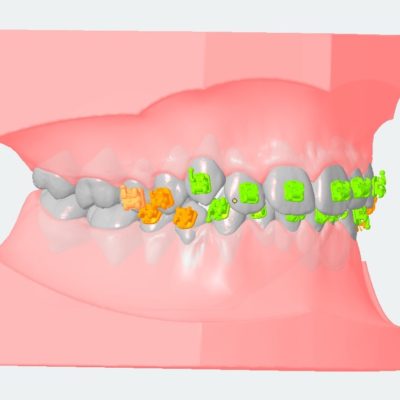
The indirect bonding of brackets allows a much shorter treatment time by the orthodontist on the chair and a more accurate and reproducible placement of the brackets. Especially for complex deformities. As a result, less must be re-glued during treatment.
With all brackets of the Dr. Baxmann concept, this technique can be performed by default and easily. We are also happy to test the use of different bracket systems for you.
While in the labial technique one can choose whether to stick directly or indirectly, the indirect bonding technique is therefore the method of choice for lingual appliances. Due to the pronounced individuality of the lingual surfaces of the teeth, direct gluing of the brackets is not recommended due to the high probability of positioning errors.
Also fixed lingual retainer can be inserted excellently with the help of the indirect technique and shorten the chair time of the doctor significantly.
Are you already relaxing or are you still gluing?
Photo Gallery:
Standard-Bracket-Technology
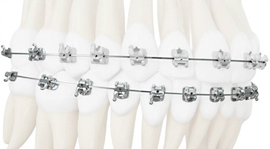
The labial multi-strap device is the most commonly used and best-known fixed device.
There are different systems and different models.
The most up to date version and our recommendation for you is working with pre-programmed brackets, the Straightwire system. Although the brackets do not correct the teeth by themselves, with some experience and our tips and tricks, it will soon be the case.
We recommend the 22 Slot system with MBT-Prescription, but of course we also like to use your desired system.
In more complex cases, the combination of the straightwire system with the segmental bow technique or the Ricketts technique is also useful from time to time.
Let us know what you want and we will implement it.
Or you can get advice. Just as you want.
Brackets

Standard bracket self-ligating metal / ceramic / lingual bracket
The brackets are the holding elements of multibracket equipment. The bow, which is ultimately responsible for the tooth movement, will be inserted into them. By preprogramming the straightwire brackets, the teeth are 3-dimensionally precisely guided by the bow and corrected. We recommend the 22 Slot system with MBT-Prescription, but of course we also like to use your desired system.
We offer you standard metal brackets for labial treatment as well as modernly self-ligating metal and ceramic brackets. Also, in the lingual technique we use self-ligating brackets. Of course, you can also use your own brackets. You and your patient choose the brackets to use.
Do you need assistance in advising your patients?
You have not introduced any AVLs yet? Contact us.
If you want to use a system that is particularly easy to use, you usually decide for a self-ligating bracket system. Clinical studies and practical experience demonstrate significant reductions in chair time.
In this case, no ligatures are necessary, in the brackets themselves, a locking mechanism is installed which securely holds the bow. This allows optimal transmission of force with very little friction and at the same time good control over the tooth movement. In concrete terms, this means less chair time, fewer treatment appointments, a shorter treatment time and the use of lower forces for gentler treatment.
In the bracket therapy, we would like to recommend you especially the indirect gluing.
This is very precise and saves you a lot of time. Here you can learn more about it.
Indirect Gluing
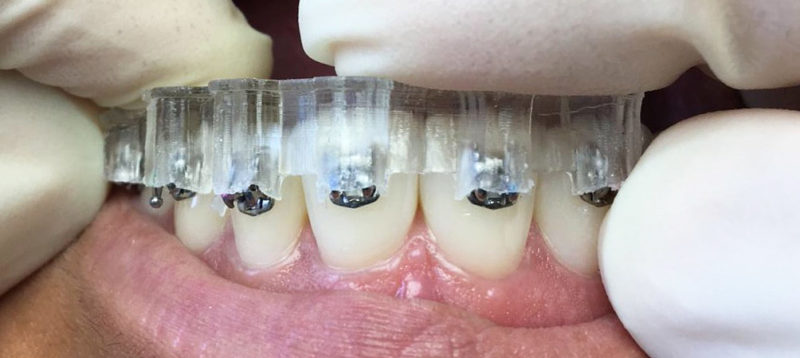
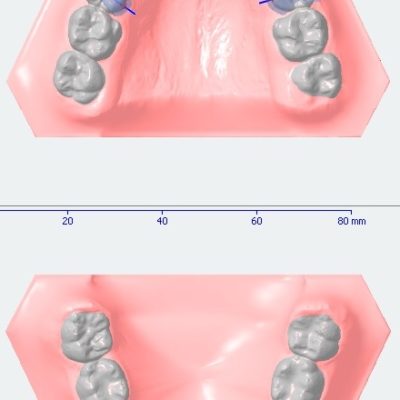
The indirect bonding technique is an indispensable part of the modern practice routine and integral part of orthodontic treatment technique.
MyOrthoLab takes this technique to a whole new level with fully digitized procedures.

Digitized brackets are perfectly positioned on the scanned digital 3D model in the lab. Individually for the respective patient. Then a digital transmission trail is created by means of software. This individual transfer tray is then printed with elastic biocompatible plastic via 3D printer.
We will send you your tray and equip it with the previously matched up brackets. Or you can have it supplied complete with brackets.
Indirect bonding is a prime example of how we can integrate the digital process chain precisely and comfortably into your practice. This saves you time and money!
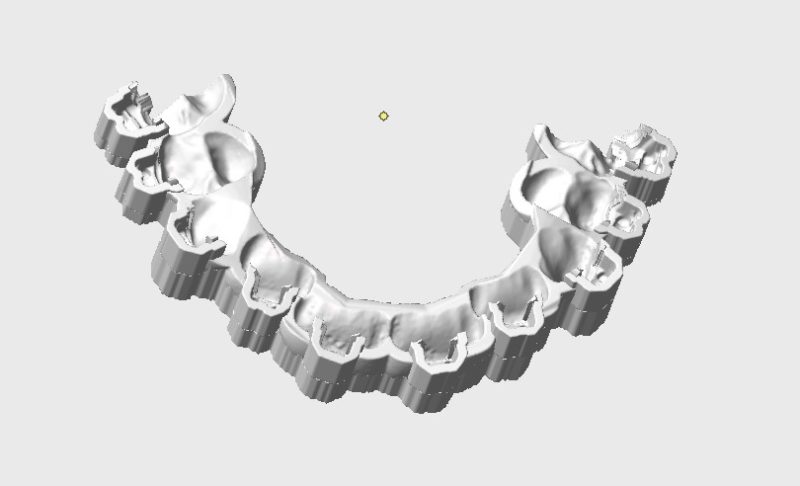
The indirect bonding of brackets allows a much shorter treatment time by the orthodontist on the chair and a more accurate and reproducible placement of the brackets. Especially for complex deformities. As a result, less must be re-glued during treatment.

With all brackets of the Dr. Baxmann concept, this technique can be performed by default and easily. We are also happy to test the use of different bracket systems for you.
While in the labial technique one can choose whether to stick directly or indirectly, the indirect bonding technique is therefore the method of choice for lingual appliances. Due to the pronounced individuality of the lingual surfaces of the teeth, direct gluing of the brackets is not recommended due to the high probability of positioning errors.
Also fixed lingual retainer can be inserted excellently with the help of the indirect technique and shorten the chair time of the doctor significantly.
Are you already relaxing or are you still gluing?
Photo Gallery:
Bows


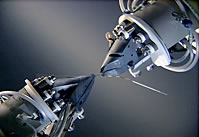
In addition to the brackets, the bows are the heart of the therapy in multi-bracket technology. They ultimately move the teeth in the desired direction to correct the misalignment. Therefore, you should choose the bows wisely. In the orthodontic market there is now an almost infinite number of different materials and bow forms.
Are you interested in force / strain diagrams? Are you familiar with the terms martensite, austenite, hysteresis or elastic modulus? Excellent! You will use the optimal bow for every treatment situation. Or are these terms perhaps less familiar?
That does not matter because we know them in detail. And we are here for you.
We are happy to advise you on the ideal materials. Super-elastic and thermo-elastic nickel-titanium bows are part of our repertoire, but of course also steel bows and TMA bows.
You may also want to know which sequence of bows would be optimal for your treatment case? We will make suggestions and explain how we would proceed.
The Dr. Baxmann concept is clear, concise and not only in his practices one of the recipes for success.
Or your treatment is almost complete, but the final precision, the fine-tuning of the result is still missing? Ask us. We bend you a finishing bow. By hand or by robotics, we can do both.
Are you already relaxing or are you still bending?
Lingual Technique

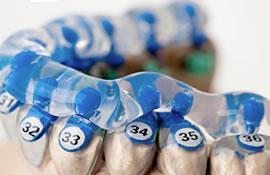
The lingual technique is the highly aesthetic variant of the labial fixed technique. It is one of the invisible braces. The brackets are placed on the inside of the teeth and corrected as usual with bows. However, this does not mean that the therapy is completely identical. The lingual technique is in our opinion recommended only for experienced users of labial technique. Courses can be found here.
The lingual technique usually uses a combination of straightwire and edgwise elements. It is worked in the 18-slot system, because by smaller distances from bracket to bracket, only very small archwire strengths ensure adequate, harmless power development. We also use self-ligating bracket systems, as this greatly simplifies and improves the attachment of the bows.
Due to the pronounced individuality of the lingual surfaces of the teeth, direct gluing of the brackets is not recommended. Due to the highest possible precision, indirect bonding is the method of choice for lingual appliances.
We offer both the opportunity to treat individual jaws, as well as the choice of whether you prefer to use an appliance of 3-3 or a complete appliance.
Discover the possibilities!
Anchoring
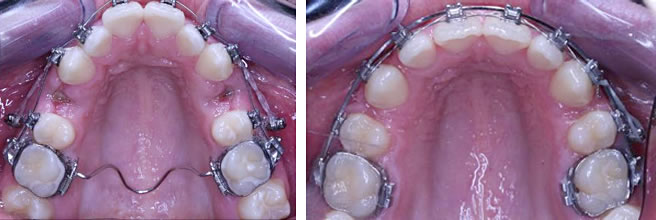
Anchoring planning is one of the central themes when it comes to successful orthodontics with few unwanted side effects.
In most cases, anchoring refers to the retention of one particular group of teeth while the other one has to be moved. With an en-mass gap closure in the extraction therapy, e.g. the molars get “anchored” and the front teeth segment distalized. The anchoring can also be anterior or secure groups of teeth vertically or transversely.
An intelligent anchoring planning is the alpha and omega of successful and reproducible orthodontics. You will be amazed how much easier it suddenly becomes.
There are a variety of appliances for this purpose. The best known are the transpalatal arch (TPA) or the often unloved headgear.
In the most up-to-date orthodontics, orthodontic mini implants are of course the standard.
We will gladly advise you on all questions of anchoring and manufacture the desired appliances for you.
If you would like a positioning aid for a mini-implant, please send us receipt that you have participated in a training course for this purpose, then we will carry out this work as usual for you. Courses can be found here.
This is for your own protection. Because we wish you success!
Expansion

soldered quadhelix. GNE. removable quadhelix
To obtain space in case of crowding and crossbites, expansion therapy is one of the main tasks in orthodontic everyday life.
In addition to the removable equipment for expansion, such as the expansion plates, however, there are also fixed equipment for this purpose. These are particularly effective, since the applied forces can be used very well. And because the cooperation of the patient becomes secondary. This is particularly important if the patient does not cooperate as desired. Fixed expansion devices have their place in all phases of orthodontic treatment, from early treatment to treatment in the mixed dentition and to complex combined jaw surgical-orthodontic treatment.
The best known devices are the transpalatal arch (TPA), the quadhelix (QH) and the palatal dilatation device (GNE).
The GNE can be used as a tooth-supported version or – for advanced users – also implant-based.
We help, you expand!
Distalization
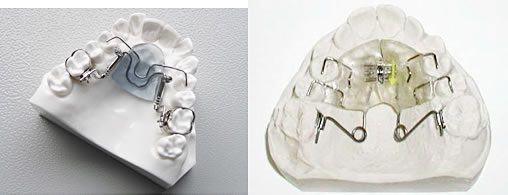
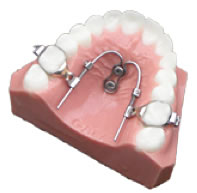
To obtain space for migrated molars and class II therapy, devices for distalization are used. The best known example of this is the outer arch, the headgear. Fortunately, however, there are now quite elegant solutions, both for the patient and for you, the practitioner.
For successful treatment, it is usually more important to decide when to get distalized than with what.
During distalization, individual molars or even the entire row of teeth are moved posteriorly. This can be done with removable devices, e.g. plates with distal screws.
However, this is safer and more accurate possible with fixed equipment. In particular, because the cooperation of the patient becomes secondary. This is particularly critical if the patient does not cooperate as desired.
These appliances are usually tooth- and mucosa-supported, e.g. the distal-jet. Of course, we also support you in using skeletal (skeletal anchored) appliances, such as the TOP-jet.
The latest developments in this area include the implant-supported devices also for the distalization.
If you want to skeletally anchor a device like the Distal Jet or if you want to use an appliance like the Beneslider, please send us receipt that you have participated in a training course for this purpose. Then we will carry out this work as usual for you.
Of course, we are happy to advise you on this. This is for your own protection.
Denn wir wünschen Ihnen Erfolg!
Class-II-Appliances
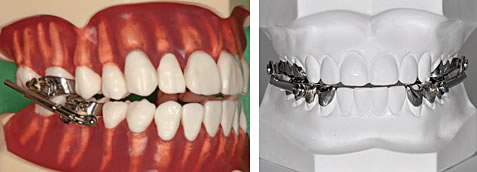
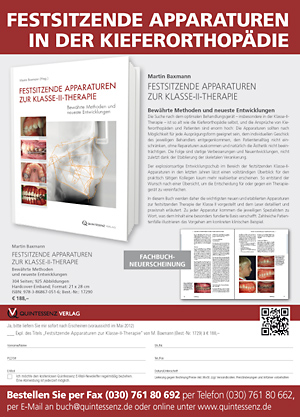
Class II is the most common dysgnathia in Caucasian patients, with a prevalence of about 70%. Due to the high significance of this malocclusion in daily practice, well-founded knowledge in therapy and choice of an appliance is indispensable.
It can be distinguished between monomaxillary and bimaxillary appliances. The monomaxillary appliances are used exclusively in the upper jaw and usually cause a distalization of the teeth rows there. Bimaxillary appliances cause a forward displacement of the lower jaw in relation to the upper jaw.
The class II therapy can be carried out with removable functional orthodontic appliances or with fixed appliances. An excellent overview of this is provided by the book “Fixed Devices in Class-II-Therapy” by Dr. Baxmann.
The advantage of the fixed Class II appliances is the independence of the cooperation of the patient. This is particularly critical if the patient does not cooperate as desired.
In addition, it has now become scientifically proven that these appliances can also be used successfully in adult patients. So, some earlier inescapable jaw surgery can be avoided today.
Tell us which equipment you want for your particular patient or let us advise you.
We not only produce the new “Baxmann Mini Telescope” for you but also Herbst-Hinges and all other appliances.
